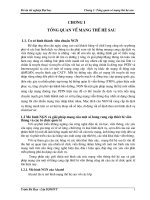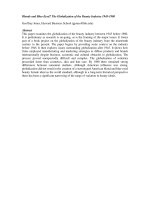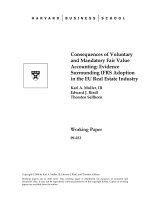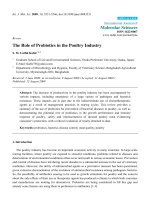THE TEA INDUSTRY doc
Bạn đang xem bản rút gọn của tài liệu. Xem và tải ngay bản đầy đủ của tài liệu tại đây (104.62 KB, 7 trang )
THE TEA INDUSTRY
The cultivation of tea in China and Japan is another of the great
industries of these nations, taking rank with that of sericulture,
if not above it, in the important part it plays in the welfare of
the people. There is little reason to doubt that the industry has
its foundation in the need of something to render boiled water
palatable for drinking purposes. The drinking of boiled water has
been universally adopted in these countries as an individually
available, thoroughly efficient and safe guard against that class of
deadly disease germs which it has been almost impossible to exclude
from the drinking water of any densely peopled country.
So far as may be judged from the success of the most thorough
sanitary measures thus far instituted, and taking into consideration
the inherent difficulties which must increase enormously with
increasing populations, it appears inevitable that modern methods
must ultimately fail in sanitary efficiency and that absolute safety
must be secured in some manner having the equivalent effect of
boiling water, long ago adopted by the Mongolian races, and which
destroys active disease germs at the latest moment before using. And
it must not be overlooked that the boiling of drinking water in
China and Japan has been demanded quite as much because of congested
rural populations as to guard against such dangers in large cities,
while as yet our sanitary engineers have dealt only with the urban
phases of this most vital problem and chiefly, too, thus far, only
where it has been possible to procure the water supply in
comparatively unpopulated hill lands. But such opportunities cannot
remain available indefinitely, any more than they did in China and
Japan, and already typhoid epidemics break out in our large cities
and citizens are advised to boil their drinking water.
If tea drinking in the family is to remain general in most portions
of the world, and especially if it shall increase in proportion to
population, there is great industrial and commercial promise for
China, Korea and Japan in their tea industry if they will develop
tea culture still further over the extensive and still unused flanks
of the hill lands; improve their cultural methods; their
manufacture; and develop their export trade. They have the best of
climatic and soil conditions and people sufficiently capable of
enormously expanding the industry. Both improvement and expansion of
methods along all essential lines, are needed, enabling them to put
upon the market pure teas of thoroughly uniform grades of guaranteed
quality, and with these the maintenance of an international code of
rigid ethics which shall secure to all concerned a square deal and a
fair division of the profits.
The production of rice, silk and tea are three industries which
these nations are preeminently circumstanced and qualified to
economically develop and maintain. Other nations may better
specialize along other lines which fitness determines, and the time
is coming when maximum production at minimum cost as the result of
clean robust living that in every way is worth while, will determine
lines of social progress and of international relations. With the
vital awakening to the possibility of and necessity for world peace,
it must be recognized that this can be nothing less than universal,
industrial, commercial, intellectual and religious, in addition to
making impossible forever the bloody carnage that has ravaged the
world through all the centuries.
With the extension of rapid transportation and more rapid
communication throughout the world, we are fast entering the state
of social development which will treat the whole world as a mutually
helpful, harmonious industrial unit. It must be recognized that in
certain regions, because of peculiar fitness of soil, climate and
people, needful products can be produced there better and enough
more cheaply than elsewhere to pay the cost of transportation. If
China, Korea and Japan, with parts of India, can and will produce
the best and cheapest silks, teas or rice, it must be for the
greatest good to seek a mutually helpful exchange, and the erection
of impassable tariff barriers is a declaration of war and cannot
make for world peace and world progress.
The date of the introduction of tea culture into China appears
unknown. It was before the beginning of the Christian era and
tradition would place it more than 2700 years earlier. The Japanese
definitely date its introduction into their islands as in the year
805 A. D., and state its coming to them from China. However and
whenever tea growing originated in these countries, it long ago
attained and now maintains large proportions. In 1907 Japan had
124,482 acres of land occupied by tea gardens and tea plantations.
These produced 60,877,975 pounds of cured tea, giving a mean yield
of 489 pounds per acre. Of the more than sixty million pounds of tea
produced annually on nearly two hundred square miles in Japan, less
than twenty-two million pounds are consumed at home, the balance
being exported at a cash value, in 1907, of $6,309,122, or a mean of
sixteen cents per pound.
In China the volume of tea produced annually is much larger than in
Japan. Hosie places the annual export from Szechwan into Tibet alone
at 40,000,000 pounds and this is produced largely in the mountainous
portion of the province west of the Min river. Richard places her
direct export to foreign countries, in 1905, at 176,027,255 pounds;
and in 1906 at 180,271,000 pounds, so that the annual export must
exceed 200,000,000 pounds, and her total product of cured tea must
be more than 400,000,000.
The general appearance of tea bushes as they are grown in Japan is
indicated in Fig. 192. The form of the bushes, the shape and size of
the leaves and the dense green, shiny foliage quite suggests our
box, so much used in borders and hedges. When the bushes are young,
not covering the ground, other crops are grown between the rows, but
as the bushes attain their full size, standing after trimming, waist
to breast high, the ground between is usually thickly covered with
straw, leaves or grass and weeds from the hill lands, which serve as
a mulch, as a fertilizer, as a means of preventing washing on the
hillsides, and to force the rain to enter the soil uniformly where
it falls.
Quite a large per cent of the tea bushes are grown on small,
scattering, irregular areas about dwellings, on land not readily
tilled, but there are also many tea plantations of considerable
size, presenting the appearance seen in Fig. 193. After each picking
of the leaves the bushes are trimmed back with pruning shears,
giving the rows the appearance of carefully trimmed hedges.
The tea leaves are hand picked, generally by women and girls, after
the manner seen in Fig. 194, where they are gathering the tender,
newly-formed leaves into baskets to be weighed fresh, as seen in
Fig. 195.
Three crops of leaves are usually gathered each season, the first
yielding in Japan one hundred kan per tan, the second fifty kan and
the third eighty kan per tan. This is at the rate of 3307 pounds,
1653 pounds, and 2645 pounds per acre, making a total of 7605 pounds
for the season, from which the grower realizes from a little more
than 2.2 to a little more than 3 cents per pound of the green
leaves, or a gross earning of $167 to $209.50 per acre.
We were informed that the usual cost for fertilizers for the tea
orchards was 15 to 20 yen per tan, or $30 to $40 per acre per annum,
the fertilizer being applied in the fall, in the early spring and
again after the first picking of the leaves. While the tea plants
are yet small one winter crop and one summer crop of vegetables,
beans or barley are grown between the rows, these giving a return of
some forty dollars per acre. Where the plantations are given good
care and ample fertilization the life of a plantation may be
prolonged continuously, it is said, through one hundred or more
years.
During our walk from Joji to Kowata, along a country road in one of
the tea districts, we passed a tea-curing house. This was a long
rectangular, one-story building with twenty furnaces arranged, each
under an open window, around the sides. In front of each heated
furnace with its tray of leaves, a Japanese man, wearing only a
breech cloth, and in a state of profuse perspiration, was busy
rolling the tea leaves between the palms of his hands.
At another place we witnessed the making of the low grade dust tea,
which is prepared from the leaves of bushes which must be removed or
from those of the prunings. In this case the dried bushes with their
leaves were being beaten with flails on a threshing floor. The dust
tea thus produced is consumed by the poorer people.









